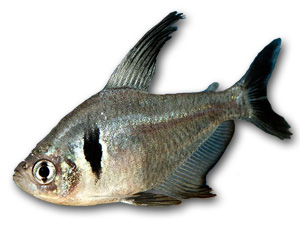Black Phantom Tetra

Quick Stats
| Size | Up to 1.75" (4.5 cm) |
|---|---|
| Tank | 60 litres + for a small school |
| Swimming Area | All |
| Ph | 6.0 to 7.5 |
| Temperature | 72ºF to 82ºF (22-28°C) |
| Food | Flakes and frozen foods as well as live. |
Common Name:
Black Phantom Tetra.
Distribution:
South America in upper Paraguay and Guaporé River basins, Rio San Francisco and central Brazil.
Colouration:
The Black Phantom Tetra males are not quite as strikingly colored as the females. But they both have the typical "tetra" shape. This shape is oval from the side view and compressed laterally. These fish have a large black patch behind the gills but in front of the dorsal fin and the anal fin is edged in black. The tailfin and the dorsal fins start out gray near the body, but quickly fade into large black areas.
Lifespan:
3 to 5 years.
Maintenance:
10 to 20% weekly water change. This attractive tetra is one of the easiest fish to keep. It is very active and can be kept in pairs or in schools. It is also very peaceful with its tank mates and a prolific breeder. The Black Phantom Tetra doesn't require exacting water conditions in order to thrive.
Feeding:
Feeding is never a problem as it will eat all flake frozen as well as live food.
Substrate:
Dark sandy material.
Tank Decor:
The tank should be well planted with artificial or live plants. Floating plants are also an option as they will make this fish feel more secure in its environment.
Filtration:
Standard filtration for the size of tank.
Biotype:
Calm, heavily vegetated water, also the Black water of the Amazon.
Breeding:
Recommended conditions: pH 5.5 - 6.0, below 4° dGH, low light levels.The Black Phantom Tetras are egg layers and very easy to breed. Similar to other tetras, they scatter their eggs among plants. The eggs are very susceptible to fungus, however, and so should have very little light. The female is more beautifully colored with red adipose, pectoral, and anal fins. The male is more of a smoky gray color and his dorsal fin is larger than the females'.